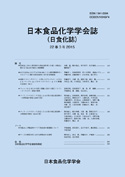Volume 29, Issue 2
Displaying 1-8 of 8 articles from this issue
- |<
- <
- 1
- >
- >|
Regular articles
-
2022 Volume 29 Issue 2 Pages 61-68
Published: August 30, 2022
Released on J-STAGE: August 30, 2022
Download PDF (1570K) -
2022 Volume 29 Issue 2 Pages 69-76
Published: August 30, 2022
Released on J-STAGE: August 30, 2022
Download PDF (1054K) -
2022 Volume 29 Issue 2 Pages 77-84
Published: August 30, 2022
Released on J-STAGE: August 30, 2022
Download PDF (1079K) -
2022 Volume 29 Issue 2 Pages 85-90
Published: August 30, 2022
Released on J-STAGE: August 30, 2022
Download PDF (859K) -
2022 Volume 29 Issue 2 Pages 91-103
Published: August 30, 2022
Released on J-STAGE: August 30, 2022
Download PDF (2012K) -
2022 Volume 29 Issue 2 Pages 104-113
Published: August 30, 2022
Released on J-STAGE: August 30, 2022
Download PDF (982K)
Notes
-
2022 Volume 29 Issue 2 Pages 114-123
Published: August 30, 2022
Released on J-STAGE: August 30, 2022
Download PDF (850K) -
2022 Volume 29 Issue 2 Pages 124-133
Published: August 30, 2022
Released on J-STAGE: August 30, 2022
Download PDF (2867K)
- |<
- <
- 1
- >
- >|
